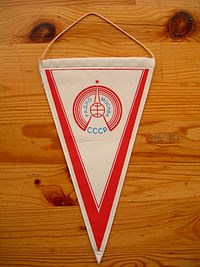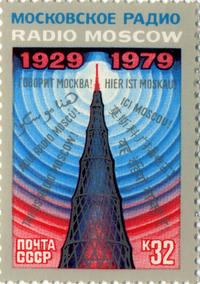- Voice of Russia
-
Russian State Radio Company Voice of Russia 
Type Radio network Country  Russia
RussiaAvailability International Owner All-Russia State Television and Radio Company Key people Andrey Bystritskiy (Chairman); Vladimir Zhamkin (Editor-in-Chief, World Service in English) Launch date 29 October 1929 Former names Radio Moscow Official website ruvr.ru Voice of Russia (Russian: Голос России) is the Russian government's international radio broadcasting service owned by the All-Russia State Television and Radio Company. Its predecessor Radio Moscow was the official international broadcasting station of the Union of Soviet Socialist Republics.
Contents
Early years
Radio Moscow began broadcasting in 1922 with a transmitter station RV-1 in the Moscow region. In 1925 a second broadcasting centre came on air at Leningrad. Radio Moscow was broadcasting (on mediumwave and shortwave) in English, French, German, Italian and Arabic by 1939. Radio Moscow did express concern over the rise of German dictator Adolf Hitler during the 1930s, and its Italian mediumwave service specifically was jammed by an order of Italian dictator Benito Mussolini during the late 1930s.
The Cold War years
The U.S. was first targeted by Radio Moscow during the early 1950s, with transmitters in the Moscow region. Later Western North America was targeted by the newly constructed Vladivostok and Magadan relay stations. The first broadcasts to Africa went on the air in the late 1950s in English and French.
In 1961 Radio Moscow for the first time spoke in three African languages: Amharic, Swahili and Hausa. Over time, listeners in Africa got a chance to tune in to Radio Moscow in another eight African languages.
The first centralized news bulletin went on the air in August 1963 and reached out to listeners all over the world. In the years of the Cold War most news reports and commentaries focused on the relations between the United States and Soviet Union.
A sample of a Radio Moscow mediumwave broadcast from the 1980s.
In the 1970s the cream of Radio Moscow's commentator teams united in a radio journal, called "News and Views". Taking part in the ambitious project were Viktor Glazunov, Leonid Rassadin, Yuri Shalygin, Alexander Kushnir, Yuri Solton and Vladislav Chernukha. Over the years the journal grew into a major information and analytical program of the Radio Moscow foreign service.
Changes 1980s–1991
In the late 1970s its English language service was renamed Radio Moscow World Service. The project was launched and supervised by a long-time Radio Moscow journalist and manager Alexander Evstafiev. Later a North American service, African service and even a "UK & Ireland" service (all in English) operated for a few hours per day alongside the regular (24 Hour) English World Service as well as services in other languages, the "Radio Peace and Progress" service and a small number of programmes from some of the USSR republics.
Broadcasting Soviet information was Radio Moscow's primary function. All programmes (except for short newsbreaks) had to be cleared by a "Programming Directorate", a form of censorship that was only removed in 1991.
At its peak, Radio Moscow broadcast in over 70 languages using transmitters in the Soviet Union, Eastern Europe, and Cuba.
Radio Moscow's interval signal was 'My Country's Vast' (Russian: Широка страна моя родная), played on chimes. This has been changed to Pictures at an Exhibition by Mussorgsky in 1991. A move has been made in an attempt to drift away from the image of the communist propaganda media.
One of the most popular programmes on air in the 1980s, due to its informal presentation that contrasted with most other shows, was the 'Listeners’ Request Club' hosted by prominent radio presenter Vasily Strelnikov. Another popular feature which began on Radio Moscow was Moscow Mailbag, which answered listeners' questions in English about the former Soviet Union and later about Russia. For almost five decades, between 1957 and 2005, the programme was presented by Joe Adamov, who was known for his command of the English language and his good humour. Radio Moscow continued to broadcast until the dissolution of the Soviet Union in 1991, and was renamed the World Service of the Voice of Russia.
Transmission network
The Voice of Russia continues to broadcast to most of the world on shortwave and mediumwave, satellite, via the World Radio Network and via the Internet. Interestingly, broadcasts with strong signals targeted at Europe continue. Many major international broadcasters no longer target shortwave broadcasts at Europe, including the Cold War rivals of Radio Moscow: the Voice of America and BBC World Service (China Radio International continues, and has expanded, short wave broadcasts to Europe).
Radio Moscow's and Voice of Russia's shortwave (SW) transmission network has never been equalled in its transmission power, directivity and reach. During the station's peak in the 1980s the same programmes could often be heard on anything up to forty frequencies on the (heavily overcrowded) shortwave bands although the station never published its complete or accurate time/frequency schedule. Shortwave hobbyists generally assumed the programming staff did not actually know what frequencies were being used[dubious ].
The transmission network consisted of at least 30 high-power transmission sites (West to East, with first transmission dates):
- Wachenbrunn, East Germany (1000 kW carrier power, MW)
- Bolshakovo (2500 kW carrier power, MW)
- Vilnius (site ceded to Lithuania, operated by Radio Vilnius)
- Saint Petersburg (1961) [16 × 200 kW SW]
- Moscow (5 known high-power SW transmission sites)
- Krasnodar (1967) [8 × 100 kW SW, 8 × 500 kW SW]
- Volgograd
- Kamo, Armenia (site ceded to Armenia, but operated by RMOC)
- Samara [6 × 250 kW SW, 3 × 200 kW SW, 7 × 100 kW SW]
- Yekaterinburg [9 × 100 kW SW]
- Tashkent (1000 kW carrier power?)
- Dushanbe (1000 kW carrier power)
- Omsk
- Novosibirsk (1956) [17 × 100 kW SW, but 1000 kW carrier power capable]
- Irkutsk (Angarsk, 1971) [2 × 100 kW, 4 × 250 kW SW, 8 × 500-kW)
- Chita
- Yakutsk
- Vladivostok (1000 kW carrier power?)
- Komsomolsk-on-Amur
- Petropavlovsk-Magadan (1000 kW carrier power?)
The transmission network is partially documented here: http://www.tdp.info/rus.html
Also there are DRM transmissions on 6 languages.
Broadcast languages
As of 2011[update] the Voice of Russia broadcasts in 39 languages, including:
VOR output compared to other broadcasters
For a comparison of VOR (RM) to other broadcasters see
Estimated total direct programme hours per week of some external radio broadcasters Broadcaster 1950 1960 1970 1980 1990 1996[1]  VOA, RFE/RL & Radio Martí
VOA, RFE/RL & Radio Martí497 1,495 1,907 1,901 2,611 1,821  China Radio International
China Radio International66 687 1,267 1,350 1,515 1,620  BBC World Service
BBC World Service643 589 723 719 796 1,036  Radio Moscow / Voice of Russia[2]
Radio Moscow / Voice of Russia[2]533 1,015 1,908 2,094 1,876 726  Deutsche Welle
Deutsche Welle0 315 779 804 848 655  Radio Cairo / ERTU
Radio Cairo / ERTU0 301 540 546 605 604  IRIB World Service
IRIB World Service12 24 155 175 400 575  All India Radio
All India Radio116 157 271 389 456 500  NHK World Radio Japan
NHK World Radio Japan0 203 259 259 343 468  Radio France Internationale
Radio France Internationale198 326 200 125 379 459  Radio Netherlands Worldwide
Radio Netherlands Worldwide127 178 335 289 323 392  Israel Radio International
Israel Radio International0 91 158 210 253 365  Voice of Turkey
Voice of Turkey40 77 88 199 322 364  Radio Pyongyang / Voice of Korea
Radio Pyongyang / Voice of Korea0 159 330 597 534 364  Radio Bulgaria
Radio Bulgaria30 117 164 236 320 338  Radio Australia
Radio Australia181 257 350 333 330 307  Radio Tirana
Radio Tirana26 63 487 560 451 303  Radio Romania International
Radio Romania International30 159 185 198 199 298  Radio Exterior de España
Radio Exterior de España68 202 251 239 403 270  RDP Internacional
RDP Internacional46 133 295 214 203 226  Radio Havana Cuba
Radio Havana Cuba0 0 320 424 352 203  Rai Italia Radio
Rai Italia Radio170 205 165 169 181 203  Radio Canada International
Radio Canada International85 80 98 134 195 175  Radio Polonia
Radio Polonia131 232 334 337 292 171  Radio RSA / Channel Africa
Radio RSA / Channel Africa0 63 150 183 156 159  Sveriges Radio International
Sveriges Radio International28 114 140 155 167 149  Magyar Rádió
Magyar Rádió76 120 105 127 102 144  Radio Prague[3]
Radio Prague[3]119 196 202 255 131 131  Voice of Nigeria[4]
Voice of Nigeria[4]0 0 62 170 120 127  Radio Belgrade
Radio Belgrade80 70 76 72 96 68 Source: International Broadcast Audience Research, June 1996
The list includes about a quarter of the world's external broadcasters whose output is both publicly funded and worldwide. Among those excluded are Taiwan, Vietnam, South Korea and various international commercial and religious stations.
Notes:
- 1996 figures as at June; all other years as at December.
- Before 1991, broadcasting for the former USSR.
- Before 1996, broadcasting for the former Czechoslovakia.
- Nigeria's external service is now off air.
In 1996, the USA's international radio consisted of 992 hours per week by VOA, 667 hpw by RFE/RL, and 162 hpw by Radio Marti.
USSR Shortwave broadcasting milestones and innovations
The USSR pioneered the use of HRS 8/8/1 antennas (horizontal dipole curtain, eight columns, eight rows, with electrically steerable pattern) for highly targeted shortwave broadcasting long before HRS 12/6/1 technology became available in the west. HRS 8/8/1 curtain arrays create a 10-degree beam of shortwave energy, and can provide a highly audible signal to a target area some 7,000 km away.
The full extent of Russia's shortwave antenna directivity research is unknown, although it is understood that some ionospheric heating experiments were carried out at the Kamo and Dushanbe relay stations in the late 1980s to 1990.
HRS 6/4/1 and HRS 12/6/1 curtain arrays are sold by an U.S. company TCI [1] in California. Marconi (UK) sold two HRS 6/4/1 antennas to Voice of America-BBG before terminating all sales and service for its longwave/mediumwave and shortwave products in the late 1990s.
The full list of available shortwave relay stations is only known by the Russian Ministry of Communications. These transmission facilities can be rented by contractual agreement. The Voice of America, Deutsche Welle and other international broadcasters have leased facilities in the past and currently possess lease agreements with Russia's MOC.
All shortwave relay station facilities in Russia and the former USSR are owned and operated by the Russian Ministry of Communications, with a few exceptions where the facilities were ceded to national governments.
See also
- Eastern Bloc information dissemination
- Radio Wolga - radio station for Soviet Soldiers in former East Germany, until 1990.
References
External links
- Voice of Russia World Service website (in Russian)
- Voice of Russia World Service website (in English)
- SWDXER ¨The SWDXER¨ - with general SWL information and radio antenna tips.
- Russia Today TV (in English)
Members of the World Radio Network Austrian Radio International · Commonwealth Broadcasting Association1 · China Radio International · Deutsche Welle · Earth & Sky · Israel Radio International · KBS World Radio · National Public Radio · Pacifica Radio · Public Broadcasting Service · Radio Australia · Radio Budapest · Radio Canada International · Radio France Internationale · Radio Guangdong · Radio Japan · Radio Netherlands Worldwide · Radio New Zealand International · Polish Radio External Service · Radio Prague · Radio Romania International · Radio Slovakia International · Radio Sweden · RTÉ · swissinfo · United Nations Radio · Vatican Radio · Voice of Russia · YLE Radio
1 The Commonwealth Broadcasting Association has dozens of members within itTelecommunications (general) History - Beacons
- Broadcasting
- Computer networks
- Drums
- Electrical telegraphy
- Fax
- Heliography
- Hydraulic telegraphs
- Internet
- Mass media
- Mobile phones
- Optical telegraphy
- Photophone
- Radio
- Radiotelephone
- Satellite communications
- Telegraphy
- Telephones
- Telephone patent controversies
- Television
- Undersea telegraph lines
- Videophones

Pioneers Mediums - Coaxial cable
- Free-space optical
- Landlines
- Optical fiber
- Radio waves
- Terrestrial microwave
Networks Geographic Telecommunications in Europe Sovereign
states- Albania
- Andorra
- Armenia
- Austria
- Azerbaijan
- Belarus
- Belgium
- Bosnia and Herzegovina
- Bulgaria
- Croatia
- Cyprus
- Czech Republic
- Denmark
- Estonia
- Finland
- France
- Georgia
- Germany
- Greece
- Hungary
- Iceland
- Ireland
- Italy
- Kazakhstan
- Latvia
- Liechtenstein
- Lithuania
- Luxembourg
- Macedonia
- Malta
- Moldova
- Monaco
- Montenegro
- Netherlands
- Norway
- Poland
- Portugal
- Romania
- Russia
- San Marino
- Serbia
- Slovakia
- Slovenia
- Spain
- Sweden
- Switzerland
- Turkey
- Ukraine
- United Kingdom
- (England
- Northern Ireland
- Scotland
- Wales)
States with limited
recognition- Abkhazia
- Kosovo
- Nagorno-Karabakh
- Northern Cyprus
- South Ossetia
- Transnistria
Dependencies
and other territories- Åland
- Faroe Islands
- Gibraltar
- Guernsey
- Jan Mayen
- Jersey
- Isle of Man
- Svalbard
Other entities Telecommunications in North America Sovereign states Dependencies and
other territories- Anguilla
- Aruba
- Bermuda
- Bonaire
- British Virgin Islands
- Cayman Islands
- Curaçao
- Greenland
- Guadeloupe
- Martinique
- Montserrat
- Navassa Island
- Puerto Rico
- Saint Barthélemy
- Saint Martin
- Saint Pierre and Miquelon
- Saba
- Sint Eustatius
- Sint Maarten
- Turks and Caicos Islands
- United States Virgin Islands
Telecommunications in South America Sovereign states Dependencies and
other territoriesTelecommunications in Oceania Sovereign states - Australia
- East Timor (Timor-Leste)
- Fiji
- Indonesia
- Kiribati
- Marshall Islands
- Federated States of Micronesia
- Nauru
- New Zealand
- Palau
- Papua New Guinea
- Samoa
- Solomon Islands
- Tonga
- Tuvalu
- Vanuatu
Dependencies and
other territories- American Samoa
- Christmas Island
- Cocos (Keeling) Islands
- Cook Islands
- Easter Island
- French Polynesia
- Guam
- Hawaii
- New Caledonia
- Niue
- Norfolk Island
- Northern Mariana Islands
- Pitcairn Islands
- Tokelau
- Wallis and Futuna
Telecommunications in Africa Sovereign
states- Algeria
- Angola
- Benin
- Botswana
- Burkina Faso
- Burundi
- Cameroon
- Cape Verde
- Central African Republic
- Chad
- Comoros
- Democratic Republic of the Congo
- Republic of the Congo
- Côte d'Ivoire (Ivory Coast)
- Djibouti
- Egypt
- Equatorial Guinea
- Eritrea
- Ethiopia
- Gabon
- The Gambia
- Ghana
- Guinea
- Guinea-Bissau
- Kenya
- Lesotho
- Liberia
- Libya
- Madagascar
- Malawi
- Mali
- Mauritania
- Mauritius
- Morocco
- Mozambique
- Namibia
- Niger
- Nigeria
- Rwanda
- São Tomé and Príncipe
- Senegal
- Seychelles
- Sierra Leone
- Somalia
- South Africa
- South Sudan
- Sudan
- Swaziland
- Tanzania
- Togo
- Tunisia
- Uganda
- Zambia
- Zimbabwe
States with limited
recognition- Sahrawi Arab Democratic Republic
- Somaliland
Dependencies and
other territories- Canary Islands / Ceuta / Melilla / Plazas de soberanía (Spain)
- Madeira (Portugal)
- Mayotte / Réunion (France)
- Saint Helena / Ascension Island / Tristan da Cunha (United Kingdom)
- Western Sahara
Telecommunications in Asia Sovereign
states- Afghanistan
- Armenia
- Azerbaijan
- Bahrain
- Bangladesh
- Bhutan
- Brunei
- Burma (Myanmar)
- Cambodia
- People's Republic of China
- Cyprus
- East Timor (Timor-Leste)
- Egypt
- Georgia
- India
- Indonesia
- Iran
- Iraq
- Israel
- Japan
- Jordan
- Kazakhstan
- North Korea
- South Korea
- Kuwait
- Kyrgyzstan
- Laos
- Lebanon
- Malaysia
- Maldives
- Mongolia
- Nepal
- Oman
- Pakistan
- Philippines
- Qatar
- Russia
- Saudi Arabia
- Singapore
- Sri Lanka
- Syria
- Tajikistan
- Thailand
- Turkey
- Turkmenistan
- United Arab Emirates
- Uzbekistan
- Vietnam
- Yemen
States with limited
recognition- Abkhazia
- Nagorno-Karabakh
- Northern Cyprus
- Palestine
- Republic of China (Taiwan)
- South Ossetia
Dependencies and
other territories- Christmas Island
- Cocos (Keeling) Islands
- Hong Kong
- Macau
Categories:- Cold War
- Eastern Bloc media
- External services (broadcasting)
- Soviet radio
- Russian media
- Russian radio
- Radio networks
- Propaganda organisations
- Communist propaganda
- Soviet brands
- Media companies of the Soviet Union
- Radio during World War II
- Arabic-language radio stations
- Armenian-language radio stations
- Chinese-language radio stations
- German-language radio stations
- Greek-language radio stations
- French-language radio stations
- Korean-language radio stations
- Portuguese-language radio stations
- Persian-language radio stations
- Romanian-language radio stations
- Russian-language radio stations
- Spanish-language radio stations
- Turkish-language radio stations
- Propaganda radio broadcasts
- 1929 establishments in the Soviet Union
Wikimedia Foundation. 2010.


